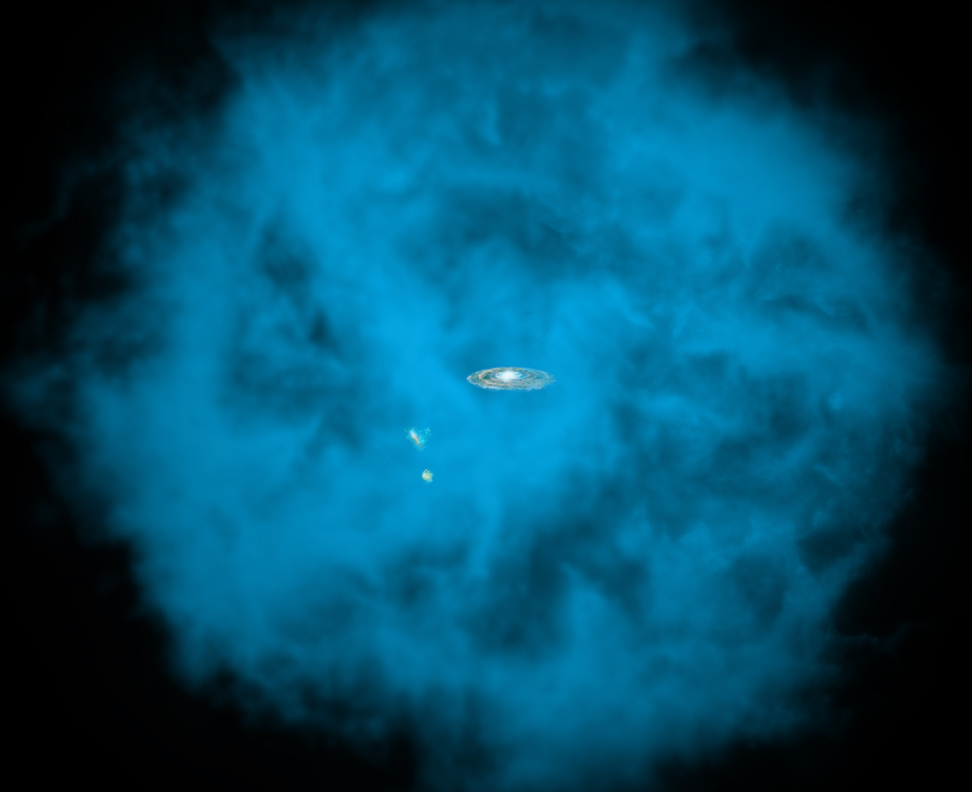
Researchers dig deep underground in hopes of finally observing dark matter
Deep beneath South Dakota, scientists are hunting the unseen.

This article was originally published at The Conversation. The publication contributed the article to Space.com's Expert Voices: Op-Ed & Insights.
Physicists like me don't fully understand what makes up about 83% of the matter of the universe — something we call "dark matter." But with a tank full of xenon buried nearly a mile under South Dakota, we might one day be able to measure what dark matter really is.
In the typical model, dark matter accounts for most of the gravitational attraction in the universe, providing the glue that allows structures like galaxies, including our own Milky Way, to form. As the solar system orbits around the center of the Milky Way, Earth moves through a dark matter halo, which makes up most of the matter in our galaxy.

I'm a physicist interested in understanding the nature of dark matter. One popular guess is that dark matter is a new type of particle, the Weakly Interacting Massive Particle, or WIMP. "WIMP" captures the particle’s essence quite nicely – it has mass, meaning it interacts gravitationally, but it otherwise interacts very weakly – or rarely – with normal matter. WIMPs in the Milky Way theoretically fly through us on Earth all the time, but because they interact weakly, they just don’t hit anything.
Searching for WIMPs
Over the past 30 years, scientists have developed an experimental program to try to detect the rare interactions between WIMPs and regular atoms. On Earth, however, we are constantly surrounded by low, nondangerous levels of radioactivity coming from trace elements – mainly uranium and thorium – in the environment, as well as cosmic rays from space. The goal in hunting for dark matter is to build as sensitive a detector as possible, so it can see the dark matter, and to put it in as quiet a place as possible, so the dark matter signal can be seen over the background radioactivity.
With results published in July 2023, the LUX-ZEPLIN, or LZ, collaboration has done just that, building the largest dark matter detector to date and operating it 4,850 feet (1,478 meters) underground in the Sanford Underground Research Facility in Lead, South Dakota.
At the center of LZ rests 10 metric tons (10,000 kilograms) of liquid xenon. When particles pass through the detector, they may collide with xenon atoms, leading to a flash of light and the release of electrons.
Get the Space.com Newsletter
Breaking space news, the latest updates on rocket launches, skywatching events and more!

In LZ, two massive electrical grids apply an electric field across the volume of liquid, which pushes these released electrons to the liquid's surface. When they breach the surface, they are pulled into the space above the liquid, which is filled with xenon gas, and accelerated by another electric field to create a second flash of light.
Two large arrays of light sensors collect these two flashes of light, and together they allow researchers to reconstruct the position, energy and type of interaction that took place.
Reducing radioactivity
All materials on Earth, including those used in WIMP detector construction, emit some radiation that could potentially mask dark matter interactions. Scientists therefore build dark matter detectors using the most "radiopure" materials – that is, free of radioactive contaminants – they can find, both inside and outside the detector.
For example, by working with metal foundries, LZ was able to use the cleanest titanium on Earth to build the central cylinder – or cryostat – that holds the liquid xenon. Using this special titanium reduces the radioactivity in LZ, creating a clear space to see any dark matter interactions. Furthermore, liquid xenon is so dense that it actually acts as a radiation shield, and it is easy to purify the xenon of radioactive contaminants that might sneak in.

In LZ, the central xenon detector lives inside two other detectors, called the xenon skin and the outer detector. These supporting layers catch radioactivity on the way in or out of the central xenon chamber. Because dark matter interactions are so rare, a dark matter particle will only ever interact one time in the entire apparatus. Thus, if we observe an event with multiple interactions in the xenon or the outer detector, we can assume it’s not being caused by a WIMP.
The hunt continues
In the result just published, using 60 days of data, LZ recorded about five events per day in the detector. That's about a trillion fewer events than a typical particle detector on the surface would record in a day. By looking at the characteristics of these events, researchers can safely say that no interaction so far has been caused by dark matter. The result is, alas, not a discovery of new physics – but we can set limits on exactly how weakly dark matter must interact, as it remains unseen by LZ.
These limits help to tell physicists what dark matter is not – and LZ does that better than any experiment in the world. Meanwhile, there's hope for what comes next in the search for dark matter. LZ is collecting more data now, and we expect to take more than 15 times more data over the next few years. A WIMP interaction may already be in that data set, just waiting to be revealed in the next round of analysis.
This article was first published by The Conversation.
Join our Space Forums to keep talking space on the latest missions, night sky and more! And if you have a news tip, correction or comment, let us know at: community@space.com.

Hugh Lippincott is a professor at the University of California Santa Barbara, which he joined in since 2019. His research focuses on the direct detection of dark matter, and has included work on a variety of experiments and techniques at SNOLAB and elsewhere. Lippincott received his PhD from Yale University for work on liquid argon and neon detectors, including with the MiniCLEAN and DEAP collaborations. He has also served as a Lederman Postdoctoral Fellow at Fermilab working on the COUPP bubble chamber experiments, before becoming a Wilson Fellow at Fermilab as a member of the PICO collaboration. Lippincott joined the LUX-ZEPLIN (LZ) experiment in 2014, for which he has served in many capacities, including as spokesperson from 2021 to 2023.
-
Questioner Dark matter is bunk.Reply
The easiest proof is it requires self contradicting properties in terms of gravity.
Think about the solar system.
Mercury is zipping around the Sun every 88 days.
The outer planets take hundreds of Earth years to make a single revolution.
Very different rotations per period (of time). (RPP)
Now look at the galactic stellar rotations from the Gaia data. (there are graphics online)
It looks like a slightly wobbly CD.
Essentially they all have about the same RPP.
So the inner stars are orbiting much too slowly & the outer stars are orbiting much too fast for standard gravity.
So the hypothized 'dark matter' in a disk galaxy would have to be in a faucet washer shape to draw the inner stars out & the outer stars in.
On the outside edge of that shape that 'dark matter' has all this 'dark matter' and its gravity on the inner side and almost nothing on the outer side.
Yet even over billions of years it is completely UN-influenced (drawn inward) by gravity.
It is itself immune to gravity.
In the middle of that faucet washer, where we are, it doesn't pile up around stars and planets and amplify their gravity so it is immune to gravity there as well.
Yet when a galaxy orbits another galaxy it does,
in contradiction with itself follow that curvature of gravity.
And it has other major problems as well.
That isn't physics that's bunk.
De Sitter & Schwarzschild relativity consistent space-times both have curvature without a single speck of matter.
'Dark matter' was a hypothesis that was born broken.









